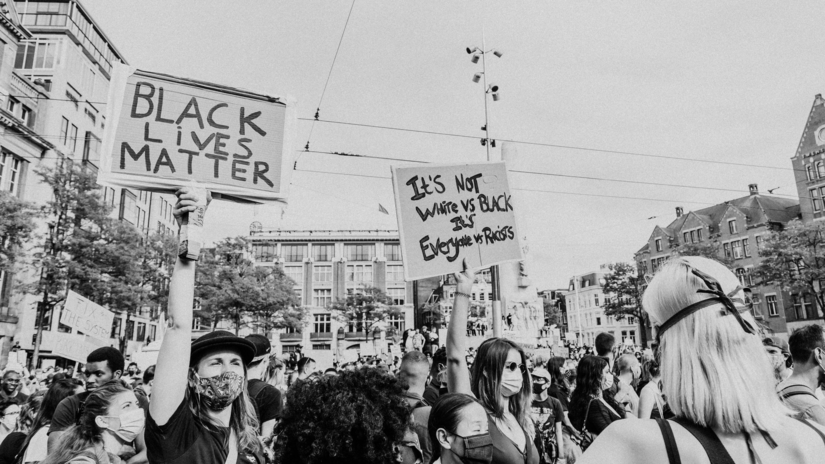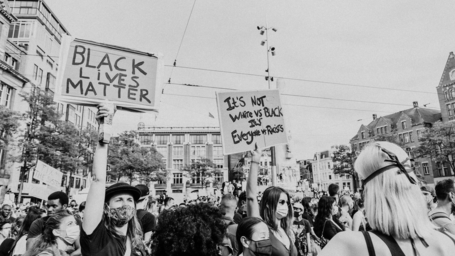In the midst of a global pandemic that was already blatantly affecting ethnic minorities and lower-income families disproportionally, George Floyd was killed by police on May 25th. His murder was yet another tragedy highlighting the prolific racism and structural inequalities that continue to exist in our society to this day. Following his murder, the Black Lives Matter movement gained tremendous traction, with hundreds of large scale protests globally, and a massive social media movement. This development was particularly evident on Instagram, which blew up with content (both helpful and unhelpful) relating to BLM. Swipe-up features usually used for retail discount codes or diet products were replaced with links urging viewers to sign a petition on change.org, calling for the arrest of the cops involved in the murders of black Americans across the country, and around the world.
Although Instagram quickly became a great resource for information on protest locations, spreading awareness, and educating followers on the prevalence of current racial issues, it also became a platform for highly performative activism. Take for example the black square which originated as part of the #BlackOutMovement, organised by the hashtag #AmplifyMelanatedVoices. While I am sure that the majority of these posts were well-intentioned, they also caused considerable harm, as people were mistakenly using the hashtag #BlackLivesMatter and consequently hindering user’s access to vital information about protests. The movement also defeated the original purpose of the posts, which were meant to elevate and amplify black voices, not drown them out with black squares.
Along with many individuals, the St Andrews Instagram page also took part in this movement, posting a black square tagged simply with #BlackOutTuesday. This, for many students, felt like an extremely hollow and performative act of solidarity when considered alongside the university’s track record of dealing (or rather, not dealing) with the lack of diversity within the student body, staff, and course materials. The university’s #BlackOutTuesday post quickly prompted a wave of comments by students relating their experiences with racial prejudice within the St Andrews community. A particularly shocking example recounted by alums was the tradition of the discriminatory ‘Bongo Ball,’ an ‘African’ themed ball run by students that took place until 2015, and was frequently hailed as one of the best events to attend in St Andrews by various student-run publications such as The Saint and The Tab. Since its controversial black square post, the university has taken some more promising and productive steps towards combating racism in St Andrews, such as creating its first Race, Ethnicity, Religion and Belief Equality Group, and collaborating with students on the ‘Racism in St Andrews Panel’ discussion between the debate society and St Andrews ACS, but for many students, this is too little, too late.
Of course, it was not to be expected that everyone would automatically know how to respond to and support the movement properly over social media. For me personally, I was conflicted about how I should be using social media during this time, and struggled with trying to share and be present in the activism that was happening online. I felt incredibly guilty for posting a scene of what I had for lunch as police brutality was breaking out all over the US. I attended protests in NYC, but like many other protesters, I could just pick up my homemade cardboard sign and return to the comfort of my apartment with few concerns about my safety. I also felt guilty for feeling like I was being pressured to share something about BLM because ‘everyone else was.’ Of course I genuinely cared about the issue, but sharing BLM content at times felt like an obligation to demonstrate my sympathy with the cause and prove that I was not complicit, rather than a productive contribution to the movement.
While it can seem overwhelming on an individual level to try and figure out how to tackle these structural inequalities, the most vital step, I would argue, is to start by looking at your own communities first. Posting a black square may have made you feel like part of the movement, but what have you done off-screen that no one else can see that will help you better understand and educate yourself about this issue?
In these moments of doubt, what I had to remind myself, and the advice that I would give to anyone in a similar dilemma, is this: the commitment you make to the movement outside of social media and the work you do behind the screen, without the views and the likes, is more meaningful and more helpful. Your allyship is not equal to the number of posts that you share on Instagram; it is equal to the time you spend thinking, reflecting, reading, watching, appreciating, and understanding racial inequality, and making steps to combat the systemic racism that exists around you.
And perhaps the most important thing that I have learned is that if you think that you are doing enough, and that you are reading/learning/listening, then you should trust yourself in that.
But if you are looking to do more (and there is always more to be done!), here are some ways that you can take productive allyship into your own hands.
-
Continue to demand equal recruitment practices and push the university to recruit students from more diverse backgrounds (BAME, lower income, disabled, etc.).
-
Educate yourself on the issue. There are hundreds of lists of resources available online containing informative documentaries, articles, and podcasts to engage with on your way to a lecture.
-
Appreciate and learn more about black artistry. Take the time to research and watch/read/listen to the hundreds of great black directors, authors, singers, poets, etc. Some of my favourites are Spike Lee, Toni Morrison, Chinua Achebe, Chimamanda Ngozi Adichie, Langston Hughes, Maya Angelou, James Baldwin, Zora Neale Hurston, the list goes on and on.
-
Support BAME student initiatives in the community.
-
Continue to sign petitions, donate, read, and join protests organised in your area!!



